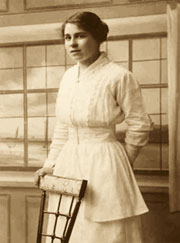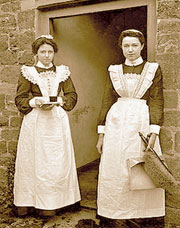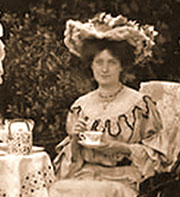Learn how to implement Pinterest Rich Pins on your website. I have hundreds of Byzanatine and Russian history images on Pinterest.
The Care of the Dining-Room
DAILY CARE
Lay a fire ready to light, then brush up the hearth, wipe the andirons and brass-work about the hearth with a dry cloth. Sweep the rugs with the carpet sweeper, and rub over the hardwood border of the floor with a dry cloth or a long-handled dust mop. Dust each article in the room thoroughly with clean cheese-cloth, being careful to take up the dust rather than scatter the same. Have the windows open meanwhile, and shake the cloth out of a window occasionally. Put fresh water into vases of flowers, and lay the table. After a meal is finished and the table cleared, roll the tablecloth over the pasteboard made for the purpose, and lay it aside. Remove all crumbs from the floor and rug, open the windows and air the room, then adjust the window shades and leave the fireplace in order. Airing the room after each meal should never be omitted.
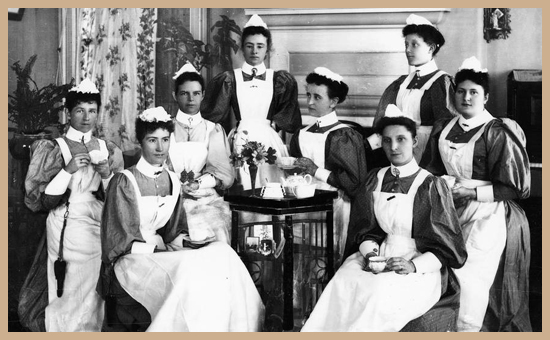 WEEKLY CARE
WEEKLY CARE
Preparations for Sweeping
Once a week clean the dining-room thoroughly. Roll small rugs, to be brushed outside. If the rug under the table be too large for care outside, push the table from the rug into one corner of the room. Over the table spread a calico cover or cotton sheet kept for this purpose. Upon this set the dishes from the sideboard and the ornaments from the mantel, and cover closely. Take down draperies that are easily removed, and hang them in the open air. Close all doors and drawers to cabinets, closets, etc. Cover the chairs or remove them from the room. Cover clock and pictures. Remove the brass and steel from position, and clean the fireplace. If there are registers in the floor, lift them out, and set on a newspaper spread upon the floor. Wipe the pipes leading from the registers to the furnace, as far as you can reach, with a cloth slightly dampened. Put the registers back in place, and shut them, to keep out the dust when sweeping. Close the doors leading from the dining-room, and open the windows.
 Above: Table and Sideboard Linen Rolled after Ironing
Above: Table and Sideboard Linen Rolled after Ironing
Sweeping and Dusting
Sweep the rug thoroughly, and with the nap, taking short strokes. Roll up the rug, and sweep the floor with a long-handled bristle brush. If the rug can be taken out of doors, spread it, nap side down, on the grass, and beat with a rattan made for the purpose. Then sweep this side. Turn the rug, and sweep the other side with the nap. Small rugs may be hung on the line, and the dust be beaten from them with the rattan. Avoid shaking rugs by the ends, which are thus easily injured. With a soft brush, such as is used by painters, brush the dust from the windows and doors, going over all mouldings and edges, the outer sill of the windows, etc, Tie a bag, made for the purpose (of Canton flannel or similar material), over the broom, and brush the ceiling, the cornice, and the walls downward. Then with a dry cheesecloth go over the doors, windows, and finishing a second time. The hearth, having been properly brushed when the floor was swept, is now ready to be washed, and the brass and steel may be polished, and replaced..
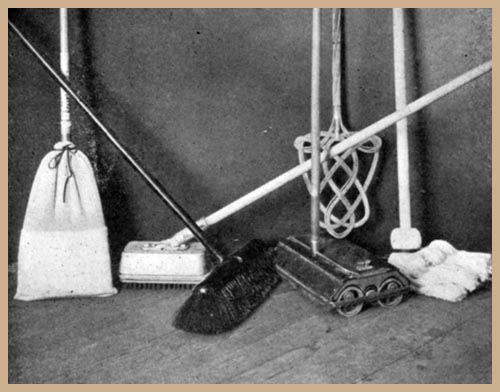 Floor Mop, Weighted Brush, Covered Broom, etc.
Floor Mop, Weighted Brush, Covered Broom, etc.
Cleaning Tiles
If the fireplace is finished with tiles, wash these with a soft cloth in soap and water, and polish with the following preparation : five pints of boiling water, two ounces of laundry soap, one ounce of sal-soda, half a pound of wax, and an equal volume of turpentine. Shave the soap and wax very fine. Add the water, and stir over the fire until the ingredients are dissolved. Then add the soda. Remove from the fire, and stir until cold. Then store in a covered vessel. When ready to use, gently heat a cup of the mixture. Remove from the fire, and gradually stir into it a cup of turpentine. Use this to clean and polish tiles or marble.
Washing Glass and Windows
First rub over mirrors, windows, glass in cabinets, etc., with a soft, dry cheese-cloth, to remove dust. Then wash with a soft cloth wrung out of warm water, in which has been put a little liquid ammonia. Wash every part of the glass. Rub dry with a clean, soft cloth, and polish with tissue paper or a piece of chamois skin. If one is willing to take time to remove all traces of whiting, this substance with household ammonia will clean glass very quickly. Mix the whiting to a thin paste with equal measures of ammonia and water. Rub this over the glass, and, when dry, remove the whiting with a soft cloth, and polish with tissue paper.
Care of Hard-wood Floor
The floor has been swept with the bristle broom, and the dust taken up. If the rug has been removed for cleaning, the quantity of dust in the room should be very small. Now wipe the floor with a dry cloth or the dry dust mop. If there are spots on the floor, wet a soft cloth in turpentine and use to remove the spots, or they may be rubbed with a cloth wrung as dry as possible out of warm water. Either the turpentine or water will destroy the polish of the floor; this must be restored by the use of a weighted brush. The weighted brush is a broad, flat brush, on which is fastened a loaded top. The brush has a long handle; by this the brush is pushed back and forth until the original polish is restored. Woollen cloths or carpet may take the place of the weighted brush; but of course, in this case, the work will be more tedious.
Care of Bristle Brush, Dust Mop (Soft Cotton String), and Weighted Brush
The weighted brush needs to be kept free from oil and perfectly clean. As it is used infrequently, it should be covered at once after use with a cotton bag. Two or three times a year cleanse thoroughly. To half a kitchen pail of lukewarm water add three tablespoonfuls of household ammonia. Put the brush into this. Let it remain half an hour. Then lift up and down in the water, and rinse in clear cold water. Let it dry slowly in a current of air. Shake the dust mop every time it is used. Twice a month soak in water to which a little household ammonia has been added. Then rinse in warm water, and dry in the open air. Wash the bristle brush in the same way, but do not let the water come up over the top of the brush.
To restore the Polish on the Dining-Table, Sideboard, or Side Table
Rub the table top free from spots with a soft cloth and furniture polish. Occasionally take some convenient time to thoroughly repplish. Powdered pumice-stone or rotten-stone, with linseed or paraffin oil, haircloth, felt, and linen cloths, are needed for this purpose. A " rubber" is a help in this work, and may be made at home. Cover a piece of hard wood eight or ten inches long and three or four inches thick and wide with several thicknesses of cotton batting. Over this fasten several thicknesses of old cotton cloth, and finish with several thicknesses of old linen. The felt or haircloth is used first, and this should be five or six inches square. Mix pumice-stone with oil to a thin paste. Spread this over a portion of the table top, and rub gently with the felt or haircloth, using first a circular movement. Then rub across, and at last with the grain of the wood. Renew the liquid paste as needed to obviate any friction, and add oil as well as paste, if the haircloth or felt does not run smoothly. Continue the rubbing until the whole surface has been gone over. Polish with the second piece of haircloth or felt until the surface is dry. Take equal parts of oil and turpentine. Wet a soft cheese-cloth in these, and go over the whole surface. Then leave the table for about an hour. Then sprinkle the surface with fine tripoli or rotten-stone, that it may take up any surplus oil. Wipe off the tripoli with the grain of the wood and with a very soft cloth. Give the final polishing with the " rubber." Powdered pumice-stone is very satisfactory for use on ordinary pieces of furniture, but for very fine and handsome pieces tripoli is preferable. Haircloth, such as is used in stiffening coats and dresses, or pieces of felt cut from old hats, are quite as satisfactory as the felt purchased from a painter, for the former may be burned after use, while the latter, being expensive, needs be washed with care, and put aside for future use.
To finish Dusting
Remove coverings from clock, pictures, chairs, etc. Shake these in the air, fold neatly, and lay them aside in their proper place. Then dust each article with care. In removing the dust from over the doors, windows, etc., avoid the use of a feather duster as much as possible. A step-ladder makes possible the use of a soft cloth and the taking up of dust rather than the scattering of it. When the room is again in order, if there be time before the preparations for the next meal are begun, the brass of the fireplace may be polished.
Cleaning Brass
Brass and copper are cleaned very easily with acids; but, unless the acids are completely and immediatelyj-emoved, the surface tarnishes again very quickly. Perhaps, all things considered, the use of salt and vinegar for cleansing, followed by polishing with rotten-stone or tripoli and sweet or linseed oil, will be found as satisfactory as any of the means commonly employed.
- 1. Mix salt with vinegar or oxalic acid.
- 2. With a soft cloth wet in this mixture rub the surface until the tarnish is removed,
- 3. Wash the brass in clear water, and wipe dry.
- 4. Polish with rotten-stone, whiting, or tripoli and sweet oil, using a woollen cloth.
- 5. Finish polishing with a dry, soft flannel.
